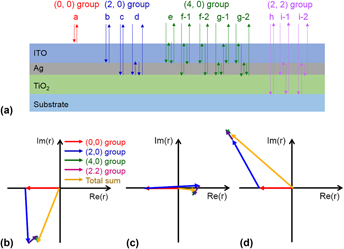Crossref Citations
This article has been cited by the following publications. This list is generated based on data provided by
Crossref.
Lee, Jeeyun
Kim, Dae-Hyun
Kim, Ki-Seok
and
Seong, Tae-Yeon
2017.
Reducing forward voltage and enhancing output performance of InGaN-based blue light-emitting diodes using metal dot-embedded transparent p-type finger.
physica status solidi (a),
Vol. 214,
Issue. 8,
p.
1600792.
Umar, Muhammad
Min, Kyungtaek
Jo, Minsik
and
Kim, Sunghwan
2018.
Ultra-thin, conformal, and hydratable color-absorbers using silk protein hydrogel.
Optical Materials,
Vol. 80,
Issue. ,
p.
241.
Im, Hyeong-Seop
Kim, Jun Ho
Lee, Sei-Young
and
Seong, Tae-Yeon
2019.
Using Ag disc array to tune infrared transmittance of ITO-based multilayer films.
Journal of Alloys and Compounds,
Vol. 785,
Issue. ,
p.
742.
Im, Hyeong-Seop
Kim, Su-Kyung
Lee, Tae-Ju
and
Seong, Tae-Yeon
2019.
Combined effects of oxygen pressures and RF powers on the electrical characteristics of ITO-based multilayer transparent electrodes.
Vacuum,
Vol. 169,
Issue. ,
p.
108871.
Chiou, Chung Chin
Hsu, Fan Hsi
Petrov, Stefan
Marinova, Vera
Dikov, Hristosko
Vitanov, Petko
Dimitrov, Dimitre
Hsu, Ken Yuh
Lin, Yi Hsin
and
Lin, Shiuan Huei
2019.
Flexible light valves using polymer-dispersed liquid crystals and TiO2/Ag/TiO2 multilayers.
Optics Express,
Vol. 27,
Issue. 12,
p.
16911.
Im, Hyeong-Seop
Huh, Daihong
Lee, Heon
Kim, Su-Kyung
and
Seong, Tae-Yeon
2019.
Forming ITO/Ag Hole-Array/ITO Multilayers for Near Infrared Transparent Conducting Electrodes and Filters.
ECS Journal of Solid State Science and Technology,
Vol. 8,
Issue. 10,
p.
Q189.
Kim, Jong-Ho
Cho, Jin-Woo
Kim, Su-Kyung
Kim, Jae-Ho
Kim, Sun-Kyung
and
Seong, Tae-Yeon
2020.
Forming high transmittance GaSnO/Ag/GaSnO conducting electrodes for optoelectronic devices.
Ceramics International,
Vol. 46,
Issue. 18,
p.
28165.
Dang, Saichao
Yi, Yang
and
Ye, Hong
2020.
A visible transparent solar infrared reflecting film with a low long-wave emittance.
Solar Energy,
Vol. 195,
Issue. ,
p.
483.
Kim, Su-Kyung
Cho, Jin-Woo
Im, Hyeong-Seop
Lim, Weon-Cheol
Kim, Sun-Kyung
and
Seong, Tae-Yeon
2020.
Formation of high ultraviolet transparent SrVOx/Ag-based conducting electrode.
Ceramics International,
Vol. 46,
Issue. 11,
p.
19484.
Fan, Xiaojuan
2022.
Flexible dye-sensitized solar cells assisted with lead-free perovskite halide.
Journal of Materials Research,
Vol. 37,
Issue. 4,
p.
866.
Zhang, Kaihua
Chen, Zhiying
Guo, Jinyang
Gao, Shuai
Yu, Kun
Zhang, Xiansheng
Liu, Yufang
and
Wu, Xiaohu
2024.
Optimization of visible transmission and NIR reflection in multilayer via PSO: Simulation and experimental validation.
Renewable Energy,
Vol. 237,
Issue. ,
p.
121913.
Singh, Narinder
and
Taunk, Manish
2024.
Metal Oxides for Next-Generation Optoelectronic, Photonic, and Photovoltaic Applications.
p.
77.



